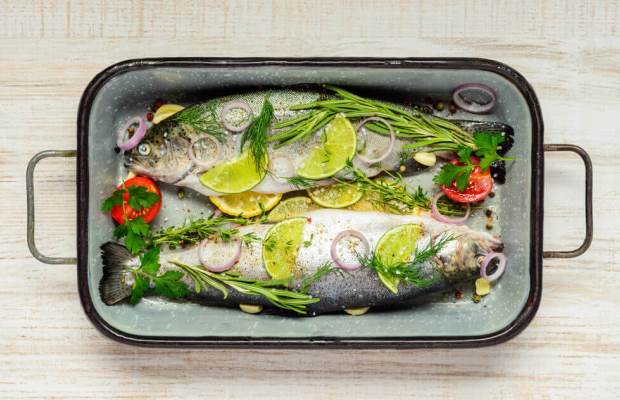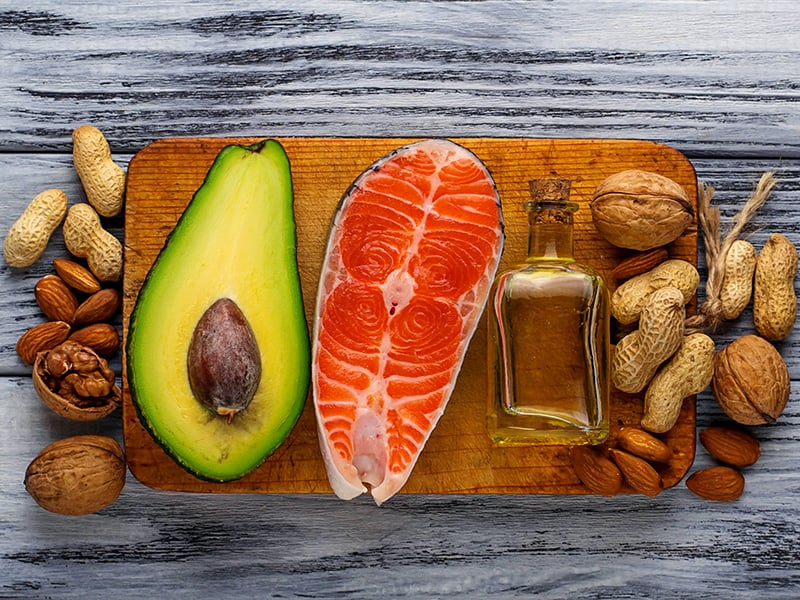What is oily fish and why is it good for you?
Oily fish are types of fish that have fat spread throughout their body, unlike white fish, which store fat mainly in their liver. This does mean they contain more fat overall, but it’s the healthy kind.
Oily fish are high in omega-3 polyunsaturated fats, particularly EPA (eicosapentaenoic acid) and DHA (docosahexaenoic acid).
These are essential fats, meaning your body cannot make them on its own – you need to get them from your diet. That’s why oily fish are recommended in healthy eating guidelines.
Regularly eating oily fish has been linked to a lower risk of heart disease. The omega-3 fats can help lower blood pressure and a type of fat in your blood called triglycerides.
They also help prevent blood clots, improve circulation and maintain a healthy heart rhythm.
In addition, they are high in vitamin D and good sources of vitamins A and B and minerals such as iodine, zinc, iron and selenium, all of which support joint health, bone strength and overall wellbeing.
Some varieties with edible bones, like canned salmon, sardines, and pilchards, are also high in calcium and phosphorus, which help keep your bones and teeth strong.
How much oily fish per week should I eat?
You should aim to eat at least 1 portion of oily fish a week, as part of a balanced diet. A portion is around 140g when cooked.
However, oily fish can contain higher levels of pollutants like PCBs, dioxins, and mercury. These substances build up in fatty tissue, so oily fish tend to store more of them than white fish.
Because of this, some people should limit their intake to no more than 2 portions a week. This includes women who are pregnant, breastfeeding, or planning to become pregnant and girls aged 11 and above.
Some types of white fish – such as sea bass, sea bream, turbot, halibut, and rock salmon – can also contain similar pollutants, so the same advice applies to them.
Oily fish list: what counts?
Oily fish include varieties such as:
- mackerel
- pilchards
- salmon
- sardines
- herring (including bloater, kippers, and hilsa)
- sprats
- trout
- whitebait (young herring)
- carp
- eel
- anchovies.
You can enjoy them fresh, frozen, or tinned – they all count.
However, it’s also important to think about how they’re prepared. Smoked, salted, or cured oily fish, like smoked salmon or tinned anchovies can be high in salt.
So, it's healthier to choose fresh or frozen fish, or tinned versions in spring water or tomato sauce rather than brine.
What does not count as oily fish?
Some fish contain omega-3 fats but are not considered oily because they’re lower in overall fat. These include fresh and tinned tuna and sea bass.
However, they are all good sources of protein so are still good choices to include as part of a healthy diet.
3 top tips to sneak oily fish into your diet
If you are not keen on the taste or texture of oily fish, you could try these easy ideas:
- Mix it into familiar dishes. You could add tinned salmon or mackerel to pasta sauces, fish pies, or risottos. Or stir flaked trout into scrambled eggs or omelettes.
- Make spreads or dips by blending mackerel (cold cooked or canned) with low-fat cream cheese, lemon juice, and herbs. Or mash tinned salmon with a 0% fat Greek yogurt and mustard.
- Make fish cakes by combining mashed potato and tinned oily fish.
How do I get healthy omega-3 fats if I do not eat fish?
If you avoid oily fish because of the taste, dietary preferences, or allergies, you can still get some omega-3 fats from plant-based foods.
Plant sources contain a type of omega-3 called ALA (alpha-linolenic acid). While your body can only convert a small amount of ALA into the more active forms DHA and EPA, it’s still worth including these foods regularly.
Fish oil supplements are not recommended.
Good plant sources of omega-3 include flaxseeds, rapeseed oil (often labelled as vegetable oil), walnuts, soya beans, tofu and dark green vegetables.
Try adding walnuts to your morning porridge, stir a mix of seeds into yogurt, or cook with rapeseed oil.
The health benefit of taking fish oil or other omega-3 supplements has been widely debated. In the UK they are not recommended to help prevent heart and circulatory disease.
If you are considering taking an omega-3 supplement, choose fish oil rather than fish liver oil supplements. Or chose marine oils made from algae, if you are vegan or vegetarian.
But as with any supplement, you should check with your doctor first, especially if you are taking any medicines, to make sure they are suitable for you.
5 oily fish recipes to try
What to read next...









